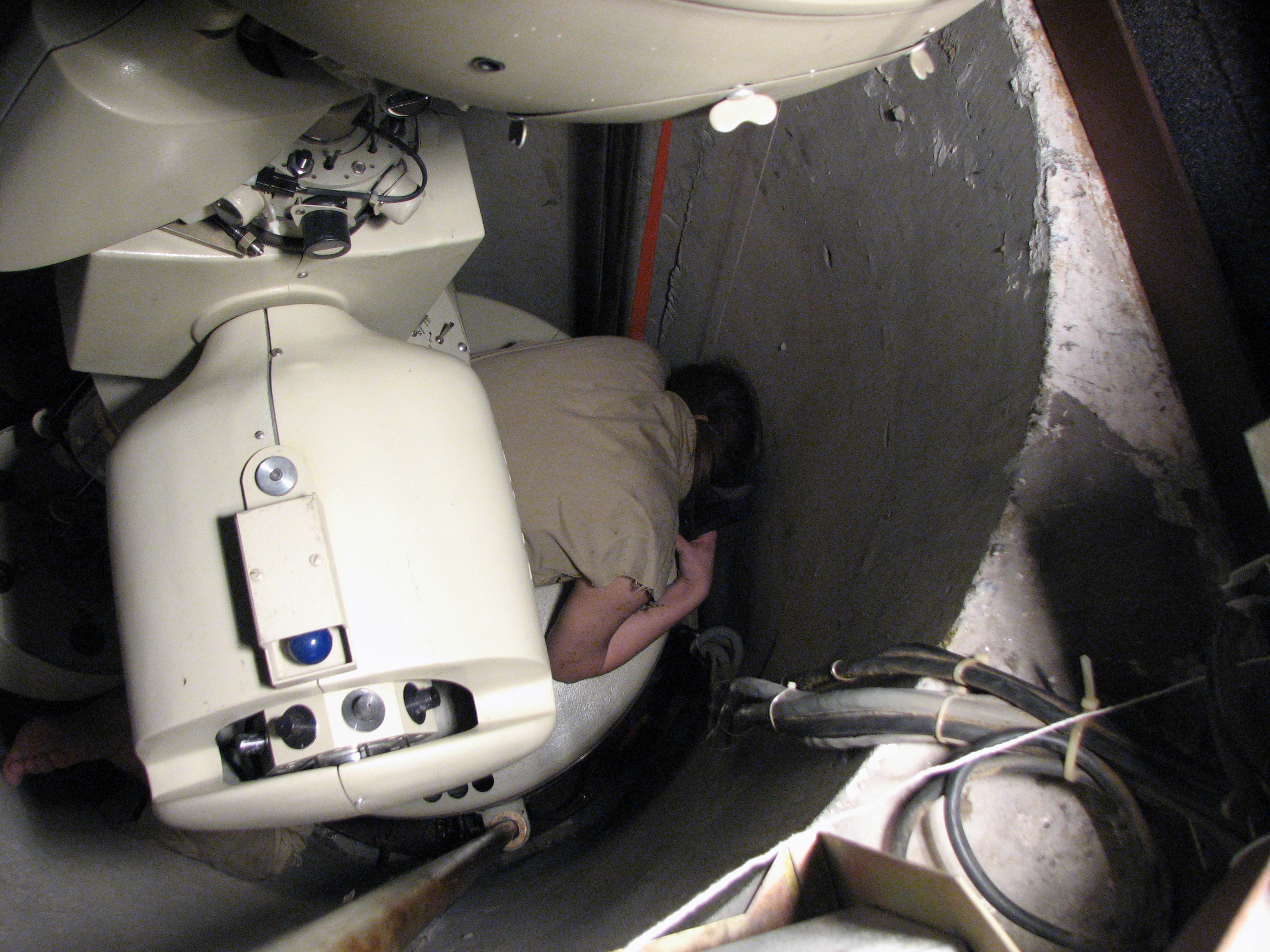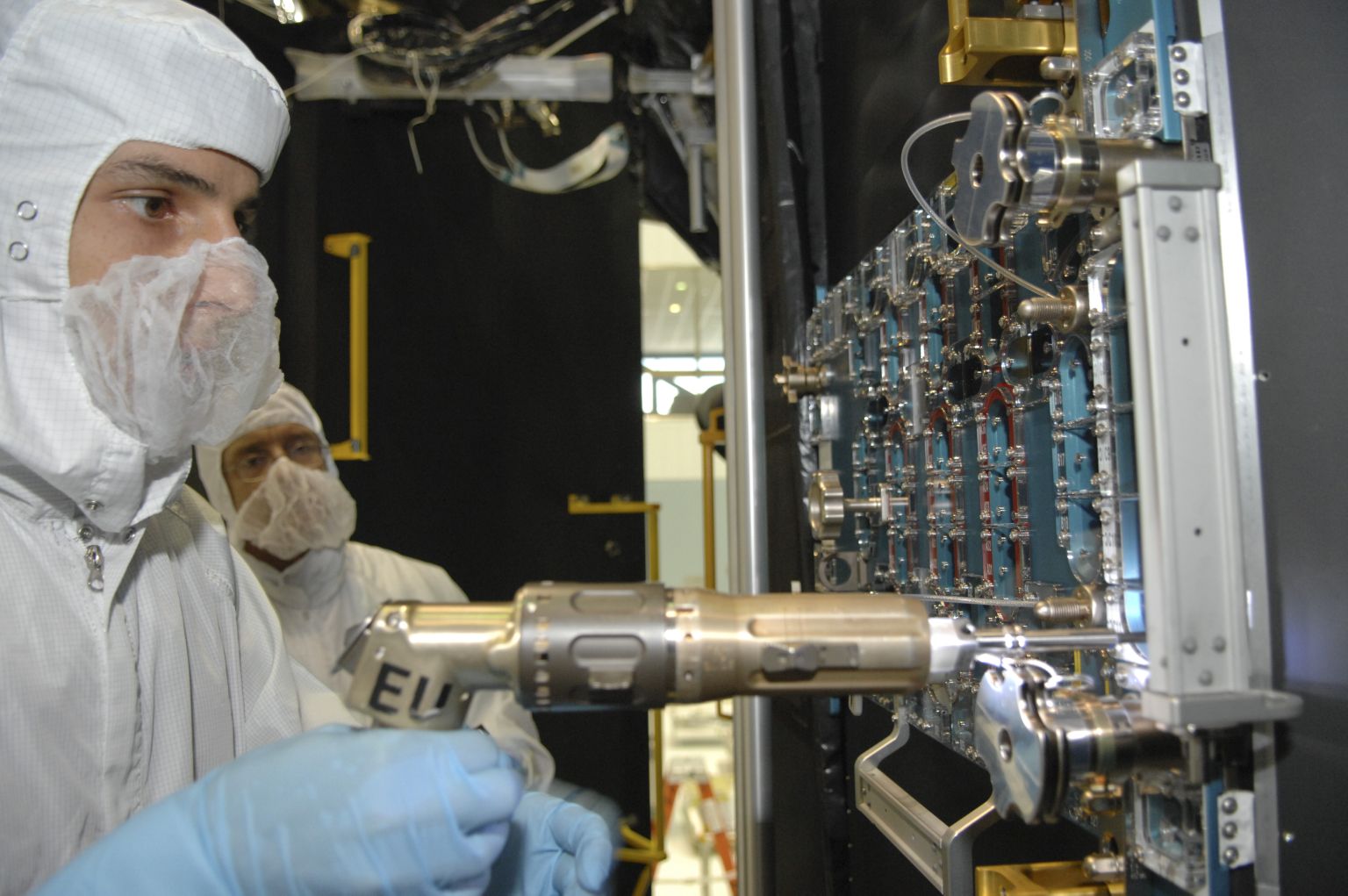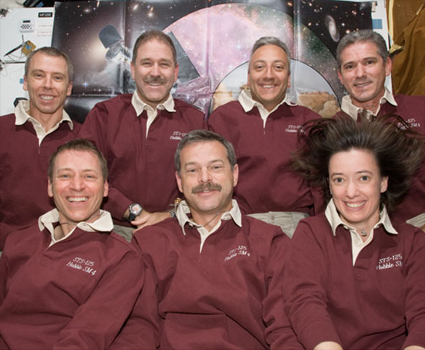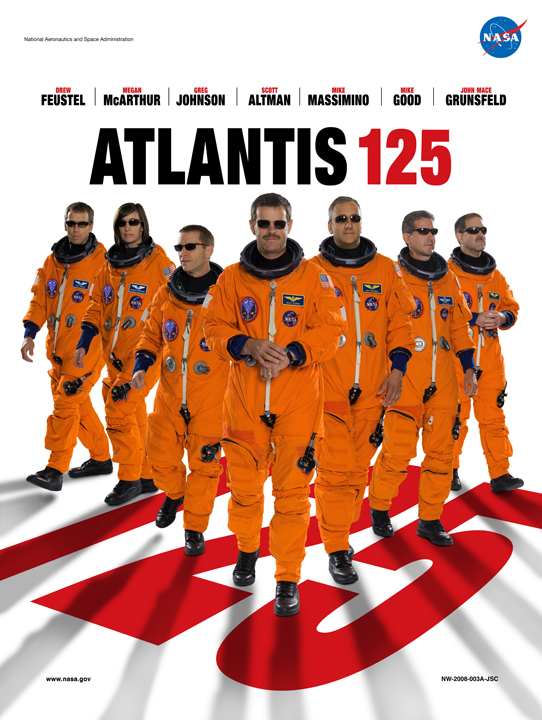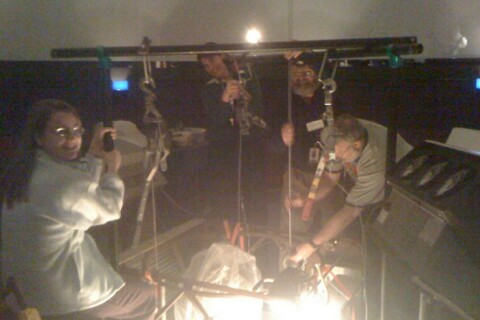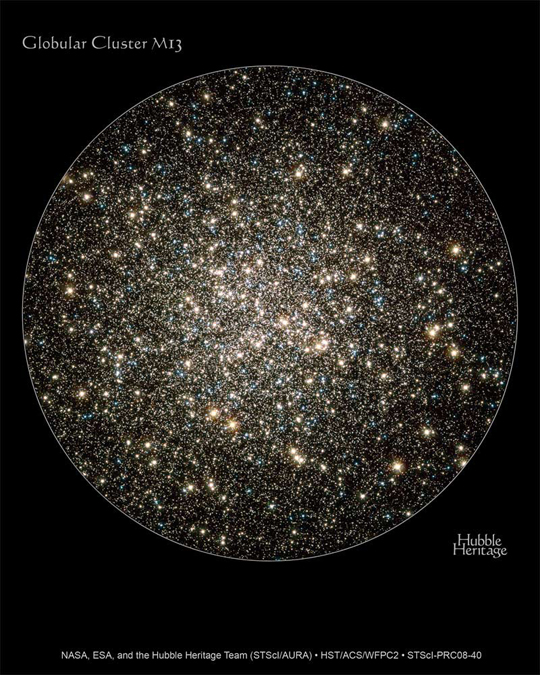Archive for 2010
 Hubble 3D vs Life
Hubble 3D vs Life
I went to see the press preview of Hubble 3D at Pacific Science Center’s Boeing IMAX Theater. It’s opening on March 19th (2010) – tickets here. Full disclosure, in case you were unaware, I am employed by Pacific Science Center but my comments here are my own.
I have been looking forward to this film for months, and I was struck by the similarity to some of what I do. So, if you will excuse the conceit, I would like to share a double story with you.
Hubble
Hubble 3D is partially just plain fun: fly-throughs of actual beautiful Hubble images, three-dimensionalized by some very talented folks who worked with some very intelligent astronomers to be as accurate as possible. As much as I love Hubble images, the other part of the movie is what I enjoyed most. The story of how to fix an ailing telescope, 350 miles above the Earth’s surface. I’ll give you some hints – but go see the movie for yourself to get the full story of the repairs to Hubble.
A Day in the Life
Then there’s what I do. In November, the planetarium projector also chose to show its age. On its way down the elevator shaft it slipped the last six inches and refused to budge. This was extremely scary for all of us, and after several calls to the techs in Pennsylvania we decided we needed to winch it up.
Here’s where it gets similar to the Hubble mission. Compare these two pictures:
The astronauts on STS-125 had quite a lot more to contend with, they were wearing space suits, the stakes were higher, their equipment larger and more expensive, but we both succeeded through teamwork, specialized tools, perseverance, and time.
Nemeses
Ah, and then the equipment just seemed to fight back:
|
This is not the handrail that Astronaut Mike Massimino had to break off, but it looks very similar and I can’t find a photo online of the broken one. |
This chain and sprocket caused a day and a half of work for several people. Arrrgh! But, we succeeded! |
Specialized Tools
|
In order to safely remove small screws in space, and be able to manipulate power tools while wearing gloves, they developed some very specialized tools for the Hubble repair missions. |
 Well, we were inspired by this – but Mark made a tool very similar, but with a slightly pointier point. Unfortunately, that tool is at the bottom of the elevator shaft now, so I can’t show you a real picture. Well, we were inspired by this – but Mark made a tool very similar, but with a slightly pointier point. Unfortunately, that tool is at the bottom of the elevator shaft now, so I can’t show you a real picture.
(Coat Hanger credit: Demion on Flickr) |
Teamwork
Want More?
Hubble 3D in IMAX – the newest IMAX space movie.
See it in Seattle (Use this link until March 19th) (Use this link after March 19th)
![]()
~ A l i c e !
P.S. All astronaut photos are from NASA. As you might expect.
 Spring Equinox Sunset – 2010
Spring Equinox Sunset – 2010
- When: Saturday, March 20, 2010 at 7:22pm (so come at 6:50pm)
- Where: Solstice Park (or, if you’re not in Seattle, wherever you have a view of the western horizon!)
- Who: Everyone welcome. as usual.
- This event is my part of NASA’s Solar System Ambassadors program, so if you have questions about NASA missions, bring them and I’ll do my best or direct you to somewhere that can answer!
Come watch the spring equinox sunset Solstice Park in West Seattle on Saturday. We’ll see if the sunset lines up with the placed marker. I’ll be there even if it is cloudy because sometimes the Sun peeks through just as it begins to set, but if it is driving rain or sleet I’m staying home with a hot cup of tea.
If you’re interested – here’s the timing of various celestial events on Saturday from Seattle, courtesy of the U.S. Naval Observatory Astronomical Applications Department
Sun and Moon Data for One Day
The following information is provided for Seattle, King County, Washington (longitude W122.3, latitude N47.6):
Saturday 20 March 2010 Pacific Daylight Time
SUN
Begin civil twilight 6:41 a.m.
Sunrise 7:12 a.m.
Sun transit 1:17 p.m.
Sunset 7:22 p.m.
End civil twilight 7:53 p.m.
MOON
Moonrise 8:21 a.m. on preceding day
Moonset 12:11 a.m.
Moonrise 8:55 a.m.
Moon transit 5:02 p.m.
Moonset 1:19 a.m. on following day
Everyone is welcome, see you there!
P.S. Thanks to West Seattle Blog for publicizing the last few! If you don’t know them, they are a great way to keep your finger on the pulse of our not-so-little peninsula.
![]()
~ A l i c e !
 Wednesday, March 10, 2010
Wednesday, March 10, 2010
We read these articles, and discussed the likelihood of life on the moons mentioned:
I handed out the homework: 2009_03_11 HW08 Space Mission (Due 3/17/2010)
You turned in your Planetary Children’s Books
We discussed the dwarf planets – so you should know the basics of them.
We also discussed “Moons of Note” – go to http://www.nineplanets.org/ or your book to check them out.
Moons of Note
- The Moon
- Phobos
- Deimos
- Io
- Europa
- Ganymede
- Callisto
- Pan
- Mimas
- Enceladus
- Titan
- Iapetus
- Miranda
- Triton (do not confuse with Titan!)
- Charon
Life
We discussed ALH84001:
http://upload.wikimedia.org/wikipedia/commons/a/a8/ALH84001_structures.jpg
http://nmp.nasa.gov/ds2/images/alh84001.gif
http://www.alicesastroinfo.com/2009/12/magnetotactic-bacteria-from-mars/
 Monday, March 8, 2010
Monday, March 8, 2010
2010_03_09 LP18 & 19 Jupiter Saturn Uranus Neptune SS Review
We discussed Jupiter and Saturn
- differential rotation
- rings
and Uranus & Neptune
- ice giant planets: see/hear this post
- “ices”
 Wednesday, March 3
Wednesday, March 3
We did a comparative planetology activity in class comparing the Earth and Mars.
We talked Human Spaceflight and I gave you a list of missions and people you should have heard of in no particular order:
- Apollo 11. Humans first walked on the Moon. 2 American men: Neil Armstrong and Buzz Aldrin. Michael Collins piloted.
- Sputnik. First man-made object in orbit – a beeping satellite from the USSR.
- The Vostok Program: Yuri Gagarin – first human in space, first human to orbit the Earth. USSR.
- Mercury (specifically “Freedom 7”): Alan Shephard – first American in space.
- STS “Space Transport System” – the official name of the Space Shuttle program. Many important occurrences.
- Pioneers 10 & 11, Voyagers 1 & 2 – Our first “close” views of the other planets.
- Hubble – Hubble’s photos changed the average person’s view of astronomy, and advanced the science immensely.
- Skylab, MIR, and ISS – these are our space stations, we had them serially not simultaneously. ISS is the only one now.
- SpaceShip One: Burt Rutan flew the 1st commercial (non-government/non-military) flight into space on a reusable craft.
- Last but not least, keep these in your heart: X-15, Soyuz 1, Soyuz 11, Apollo 1, Challenger, Columbia.
- Just a couple inspiring names: Sally Ride, Valentina Tereshkova, John Glenn, Shenzhou
- Want more?
- Disaster Details
We determined that all rocky solar system objects are mostly grey, with the exception of the outside edge of Mars rocks.
- differentiation is a good term for you to look up.
 Last-Minute Stargazing Tonight – West Seattle
Last-Minute Stargazing Tonight – West Seattle
I declare it is time for another last-minute star party in West Seattle. This will be my second event as one of NASA’s Solar System Ambassadors.
- Tonight, Saturday, March 6, 2010
- Start: 9pm – I may leave around 10 or 10:30 unless no one shows up.
- Solstice Park as usual (at the TOP, if you’re by the tennis courts go up)
As always, this is if the weather is permitting. If you can see stars I’ll be there (unless it gets really super freezing cold).
Telescopes – Mars first, Saturn later?
I’ll bring a couple telescopes, you should bring one if you have one. We’ll look at Mars definitely, and maybe Saturn if it comes up over the trees in time.
Unfortunately, we’ll miss seeing the international Space Station, but if you wanted to step out of your house earier, you can see it around 7:47pm, starting West-Southwest.
| Date | Mag | Starts | Max. altitude | Ends | ||||||
| Time | Alt. | Az. | Time | Alt. | Az. | Time | Alt. | Az. | ||
| 6 Mar | -3.1 | 19:47:37 | 10 | WSW | 19:50:30 | 62 | NNW | 19:50:32 | 62 | NNW |
GLOBE at Night
This would be a perfect opportunity to get your GLOBE at Night observations in. Wait, you don’t know about GLOBE at Night? Well check this out – you can help out on a worldwide science project to determine how stargazing quality is changing around the world. Plus, I’ll be around to help out if you need it (but I don’t think you will). The Lat/Long of Solstice Park is (47.536341, -122.39052).
See you tonight!
![]()
~ A l i c e !
 Monday, March 1, 2010
Monday, March 1, 2010
Evolution of the Solar System: Go here for the activity we did in class. Understand the basics.
Review what the book has on the terrestrial planets: Mercury, Venus, Earth and Mars.
Keywords to research:
- Comparative planetology
- Resonance (in terms of orbits)
- Tidal Lock
- How Craters form, and what they look like
- Albedo
- Shield vs composite volcanoes
 March-April 2010 Sky
March-April 2010 Sky
Upcoming Events
March 3-16, 2010 – GLOBE at Night
The annual citizen-science stargazing event is back! Go outside any one of the above dates and take a look at Orion – no telescope or binoculars needed. GLOBE at Night wants to know how many stars you can see with just your eyes. But wait! They make it easy – you don’t have to count the stars – just compare what you see to diagrams, and pick the one that matches and submit your observations online. This data will be compiled into maps which will help astronomers track light pollution and how stargazing quality in various parts of the world.
Go to their webpage, download an observation packet, and take your family out to your backyard for some real science!
You’ll need to know your latitude and longitude:
Seattle is at: 47°37’N, 122°20’W
8:30pm Saturday, March 27, 2010 – Earth Hour
All you have to do for Earth Hour is turn off your lights – especially your outdoor lights for one hour at 8:30pm on March 27th. It’s that easy. Earth Hour is about awareness of energy conservation and climate change – with the added benefit of supporting Dark Skies Awareness and making stargazing awesome even in big cities.
You can sign up and get more information, or just turn off your lights. Tell a friend; ask your neighborhood businesses to participate. Anything you do helps.
Constellations and Observables:
Notable Sky Objects
MARS
Mars is high, bright, and beautiful in March and April. Look for a bright reddish star near the zenith – or check the starmap above for more detail. Mars was just at opposition a month ago, so now is still a wonderful time to look at it.
SATURN
Saturn is also high in the sky as the night wears on, rising later than Mars, but visible most of the night.
JUPITER, MERCURY, VENUS
Jupiter, Mercury, and Venus are all too close to the Sun to be visible.
New Constellations
BOÖTES – The Herdsman
SCIENCE: Arc to Arcturus, Speed on To Spica. This is how you find Boötes using the curve of the handle of the Big Dipper – and then that leads you on to Spica in Virgo!
Tau Boötes (sorta Boötes’ left foot) has an extrasolar planet! One of the so-called hot Jupiters. You can see this star just to the right of Arcturus – it’s the crook (corner) star off the little triangle that you’ll see there.
MYTH: The modern myth is that Boötes invented the plow, and therefore farming, and he’s the only “regular person” up in the sky – everyone else is a God, or partially Godlike, or something. I love this myth, because I can explain that Boötes is why we have cell phones and planetariums. It turns out that several different cultures depict Boötes as a herdsman or a farmer: the Saudi Arabians, the Egyptians (to whom the Herdsman is so important he also represents Osiris), the Greeks, and the Christians. Yowsa.
VIRGO – The Virgin (or “Princess”)
SCIENCE: Arc to Arcturus, Speed on To Spica. This is how you find Boötes using the curve of the handle of the Big Dipper – and then that leads you on to Spica in Virgo!
We are part of the Virgo Cluster Supercluster of galaxies – and it’s called the Virgo Supercluster Cluster because to see the rest of the galaxies in our group you look towards Virgo. There’s a bunch of beauties out there by Virgo’s face, so if you’ve got a scope, take a look, and if you don’t, look up some pretty pictures of our group of galaxies – most of them are over there.
MYTH: Worried about talking about virgins in mixed company? Well, princess is a perfectly acceptable way to talk about Virgo, also “girl” is good too. If your audience is up to it, you might mention that this virgin usually represents the Greek goddess of justice – so I wouldn’t try to cross her if I were you.
CORONA BOREALIS – The Northern Crown
SCIENCE: There’s not much too Corona Borealis, but it is a very noticeable grouping of stars, and therefore quite helpful in finding Hercules, especially in our murky Seattle skies.
MYTH: Obviously the Greek myth is about a crown, but the Housatonic Native Americans call this Ursa Major’s cave!
HERCULES – Hercules
SCIENCE: Do not miss M13 – the Hercules Globular Cluster! This is one of the oldest groups of stars in our galaxy – it’s like the old-folks home of stars.
MYTH: “Hercules is one of the oldest constellations, found in the cave drawings of primitive cultures. Not even the Greeks were sure of his origins. We are aware that very early cultures worshipped him, but who and what his starry figure stood for is a mystery.
“About 300 BC the Chaldeans said that this figure was standing victorious on the head of a twisting serpent. They associated these two figures, Hercules and Draco (the serpent) with their sun god, Ishdubar.
“The Chinese called Hercules ‘Titso’ or ‘the emperor’s seat’.” (From Zeta Strickland)
“Tiny” Guys
Going for the Gold? Here’s this month’s itty-bittys.
SERPENS – The Serpent
LYRA – The Lyre (just starting to peek up)
CORVUS – The Crow
CRATER – The Cup
COMA BERENICES – Berenice’s Hair
CANES VENATICI – The Hunting Dogs
LYNX – The Lynx
SEXTANS – The Sextant
HYDRA – The Sea Serpent (Big and dim, so big that it’s close to being biggest Northern Hemisphere constellation)
ANTILA – The Air Pump (Maybe you’ll see it, but it might be too far south)
MONOCEROS – The Unicorn
LACERTA – The Lizard
LEO MINOR – The Small Lion (Between the Big Dipper and Leo)
CAMELOPARDALIS– The Giraffe
Returning Constellations
LEO – The Lion
CANCER – The Crab
CANIS MAJOR – The Big Dog
ORION – The Hunter
TAURUS – The Bull
GEMINI – The Twins
CEPHEUS – King Cepheus
DRACO – The Dragon
URSA MAJOR – The Great Bear
URSA MINOR – The Little Bear
CASSIOPEIA – The Queen
Happy Sky Viewing!
Where’d I Get My Info?
My memory, and Zeta Strickland
![]()
~ A l i c e !
 Spring
Spring
… and suddenly it was spring!
Enjoy a picture …
What? Not “astronomy” enough for you? Astronomy is the REASON we have cherry blossoms in spring!
… and Three Carnivals!
Carnival #142 – with wonderful illustrations, and featuring two of my posts! Check it out.
![]()
~ A l i c e !

